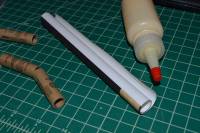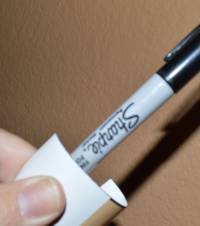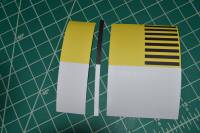Two Stage MMX Paper Thor
By Scott Johnson
2014-10-24
I've built a Bob Harrington Mini Thor and have a few pictures on the build process. I altered the Mini Thor, originally designed to run with a single A-T engine, into a two stage MMX model.
You can get the Thor and many others here: http://rocketry.wordpress.com/ultimate-paper-rocket-guide/paper-rocket-partial-builds/
First step is to print and place an initial clear coat on the page. Just one or two passes - the glue still needs to hold later on.

The extra white pages are to prevent debris from being kicked up and glued on to my page.
I later taped this page to a glass table to retain it's flat shape while it dried.
Tube wrap and glue
2014-10-24
Before wrapping the tubes, edge any areas of the paper where the printing is black with black sharpie. This will reduce white lines exposed by the edges.
Don't do this with the yellow and tan segments as you'll see where the ink bleeds. below is a white inner tube segment that will get black because the outer visible tube is black.

I cut the tubes out and wrapped the tubes around A-T engines. They need to be very tightly wrapped.
I actually left mine wrapped for a few days while working on and other rocket, but that is probably not necessary.
![]()
Then I glued per the instructions. Here I exposed a portion of inner tube and glued it to hold the tube together. The rest of the tube is full of A-T engines.

After the glue was dry, I unrolled the tube, removed the engines to prevent them from being glued in, and painted glue thinly on the inner exposed piece of paper out to the edges. Roll tight and wipe excess glue off with a barely moist towel.

All tubes were completed the same way.
The exposed paper edge was burnished with a sharpie pen to ensure it remained flat and firmly glued against the rocket.
Two Stage Set Up.
2014-10-24
Below are the paper sections for the first and second stages.

Parts lay out for Two Stage MMX Mini Thor.

From Left to right.
1) Thor body
2) Coupler for Thor body and second stage.
3) Second stage MMX guts
4) First stage MMX guts.
This build is set up like most Estes two stage models I've built.
Fins...
I constructed all the fins the Chris Michielssen way. Check out his Carded Satellite Interceptor directions here: http://modelrocketbuilding.blogspot.com/2012/05/carded-satellite-interceptor-build-part.html
Part 2) Fin Lamination.
Chris, also has a paper Black Brant VB, but Chris made that one and it's much easier, because the fins just fold together. So for the Thor use his Carded Satellite Interceptor method.
When gluing fins to the body, do the first stage. Then attach both stages together and ensure the fins align when gluing on the second stage.
First Stage Done
2014-10-24
Here is what the completed first stage looks like with the engine installed.
1)  2)
2)  3)
3) 
Second Stage and Thor Body
2014-10-24
Here is the second stage and Thor body completed.

Bottom of Second Stage.

Streamer installed and done.
Mini MMX Thor Done!
2014-10-24
Done.

Final Clear Coat
2014-10-25
Now that it's done I'm going to put a final clear coat on the rocket.
Final MMX Note:
2014-10-27
This excerpt is from the Fliskits Doubles Rocket page (http://www.fliskits.com/products/rocketkits/micromaxx/kit_detail/doubles.htm) and refers to how staging works with MMX motors.
IMPORTANT: The NE motors have no ejection charge, but they DO have a delay charge. This is about a 1 second delay, which doesn't sound like much. However, for rocketeer’s familiar with multi-stage rockets, you are used to the instant staging that comes at the moment of booster burnout. NO SO with micro multi-staging. Rather you get a 1 second delay between booster burn out and sustainer ignition. This can be very nerve racking, if you aren't expecting it!
Also, be sure to have an alert recovery crew as you want to be sure to recover your booster as well.
Sponsored Ads
 |
 |

















